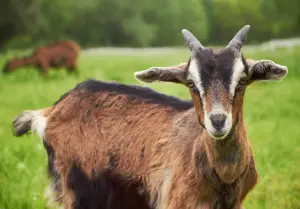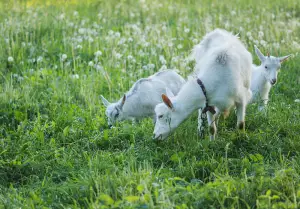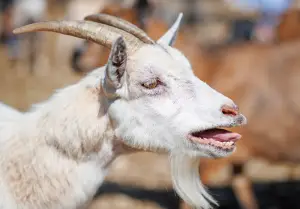How Do Goats Communicate?
As science advances and awareness of animal intelligence increases, we learn new and fascinating facts about what animals are actually thinking or doing all the time. Several behaviors that humans previously ignored as just a thing that animals do have been shown to actually have social or health-indicating significance.
So, how do goats communicate? While goats come with strong vocalization abilities, they also display a variety of behaviors to communicate with each other as well as with humans. Goats communicate through facial expressions, ear position, various movements, and a range of vocalizations to express fear, pain, interest in breeding, dominance, and even happiness and contentment.
Read on to learn all the fascinating ins and outs of how goats communicate!
How Goats Communicate With Each Other
Most things goats do to communicate their feelings make sense once you understand them. You’ve probably seen the majority of these communication methods in other animals or even humans. With a stronger comprehension of goat body language, you’ll be more equipped to understand what your goats are saying and how to address the situation.
Interestingly, goat herds always have a head female who is in charge of when the herd goes out to the pasture. She also tries new foods first, and gets the best choice of feeding space and the most desirable place to sleep. The head male hangs around the back of the herd and makes sure everyone else keeps up. He is usually the biggest, probably the most scarred from winning many battles, and likely one of the oldest members of the herd.
The head goat’s kids are automatically directly under her in the pecking order. She allows them to eat in the best places with her without them having to prove themselves in brawls against other goats.
How Goats Communicate Happy Behaviors
Like dogs and horses, upward-pointing ears indicate happiness in goats. Oftentimes goats who feel content and comfortable keep their ears pointing to the sky.
When goats feel safe and at ease with other members of their herd, they will often sleep near each other and sometimes even cuddle close together.
Goats learn a lot about their environment by tasting/nibbling. If you see a goat pulling down the wash or mouthing non-edible objects, it is likely that they are merely investigating and not actually trying to eat things they shouldn’t. However, it is best to prevent access to small, indigestible objects. Provide your goat with items that are too big to accidentally swallow as good options for investigating.
How Goats Communicate Dominance 
All goat herds have a natural hierarchy or pecking order. This is established by individuals fighting for the highest rank and, therefore, the first pick of food sources and potential mates. Oftentimes the bigger the body and horns a goat has, the higher up in the pecking order the goat is because of successful fights against the competition.
Headbutting is the most common way for goats to fight out the dominance hierarchy. Unlike rams, fighting goats don’t back up and then charge their opponent. They glare at each other for a while, then rear up and move in different directions in a dominance display, then slam their horns into each other.
Animals fighting for dominance typically hold their ears flat against their heads to show annoyance.
Fear and Discomfort Behaviors In Goats
While flat ears indicate annoyance and erect, mostly-still ears are a sign of happiness and contentment in goats and other animals, ears that swivel rapidly back and forth are a sign of distress. The swiveling is the goat trying to listen for a sound that could indicate danger. This can sometimes be accompanied by a frantic head swiveling as they search their surroundings for visual evidence of dangers.
Have you ever seen the hair along the spine of a dog or cat stand on end when they’re startled or annoyed? Goats do the same thing when startled or feeling annoyed. This behavior can precede an angry charge at whatever is causing the negative reaction.
In extreme heat and humidity, goats will pant like an overheated dog. The humidity is more distressing to goats than the heat, but with uncomfortable levels of either, goats are also more likely to be irritable with each other.
If you see your goats panting, take action to help them cool down. Provide a better shelter, ensure they have plenty of water, and consider installing fans to further assist with cooling. Overheating has been shown to cause stunting of growth in young goats and decreased meat and milk production in adults.
Because goats are prey animals, they are very good at hiding sicknesses and injuries. They conceal the evidence of these things because predators know to look out for them in order to identify the easiest animals to prey on. So if your goat, who was limping a moment ago, suddenly darts away when you approach, it doesn’t mean that you imagined the limp. That’s just the goat doing her best to appear healthy and uninteresting to a potential threat.
Some goats also appear to faint when startled. This is especially common with the famous fainting goat breed. With these individuals, the process their bodies go through to react to fear causes their muscles to lock up, which makes them fall over. Only their muscular systems are affected. There is no negative effect on their nervous systems like there would be with a true faint. So this behavior isn’t actually harmful to them, and they recover soon after falling over.
Goat Mating Behaviors
The introduction of a male into a group of females will cause the females to begin going into a reproductive state. This change in the bodies of the females causes a change in the scent of their urine, which signals to the male that they are ready to breed.
The male will then begin urinating on himself to make his masculine musk as pronounced and noticeable to the females as possible. This is one reason female goats make better pets than males. The females smell significantly less.
There are two main behaviors exhibited by females who are ready to mate. The first behavior is called “proceptivity” and involves the female seeking out and stimulating the male goat by wagging her tail. The second behavior is called “receptivity.” This is when a female goat stands still and accepts the attention of the male.
Maternal Behaviors In Goats 
Mothers lick their newborn kids extensively right after birth. This helps develop the maternal bond through exposure to the newborns’ scents. If this behavior fails to take place for some reason, a mother may reject an unfamiliar kid later on because she didn’t get the chance to get used to its scent and understand that it was hers.
Sight and sound recognition is another part of developing the maternal bond. A new mother develops sight and sound recognition of her kids within four hours of giving birth. Every goat kid has a different scent and a unique bleating sound that mothers are proficient at differentiating.
As the kids grow and get closer to weaning age, the mother will reject their attempts to suckle more and more often. This is a necessary behavior to encourage the kids to begin developing a reliance on solid food sources.
Goat Grooming Behaviors
Goats scratch their necks with their back hooves as part of their grooming process. They also lick themselves to keep clean. Goats are actually very clean animals. If a goat smells bad, it could be due to breeding season rituals. But if a goat is not well-groomed, such as having matted or dirty fur with twigs and things all over, that could be a sign of a health condition.
Arthritis can make grooming too painful to keep up with. Other health problems could leave a goat too short on energy to keep itself well-groomed. Poor grooming is a good reason to take a closer look and consider consulting a veterinarian before any illnesses become more dangerous.
How Do Goats Communicate with Humans?
Once a goat has gotten used to your presence and associates you with good things, it will readily approach you for pets and/or treats. Even if other goats are less sure about you, odds are they’ll follow in the braver goat’s footsteps and approach you for their own pets and treats.
Goats show affection and trust to humans by rubbing against their legs, following them around, and even by bleating for attention. They tend to enjoy being pet on the neck and chest more than on their backs.
Just as dogs sometimes stare affectionately at their owners, goats seem to engage in the same behavior. Goats will stare at familiar humans for what seems to be the same reason.
Another reason for goat staring is to ask for help. If a goat can’t figure something out or is insecure in a new situation, it may look at its trusted human for direction. This is a good sign that a goat trusts you and feels safe around you.
Interestingly, some studies have shown that goats have some understanding of human facial expressions. When exposed to photos of various facial expressions, goats were significantly more likely to approach the happy and welcoming expressions and tended to avoid the less inviting expressions.
So smile at your goats and give them lots of pets. If you are trying to win over an especially timid goat, try sitting on the ground to make yourself smaller and try tempting them near with treats. Once they begin to associate you with tasty goodies, kind facial expressions, and friendly pets, even shy goats will get more comfortable around you.

